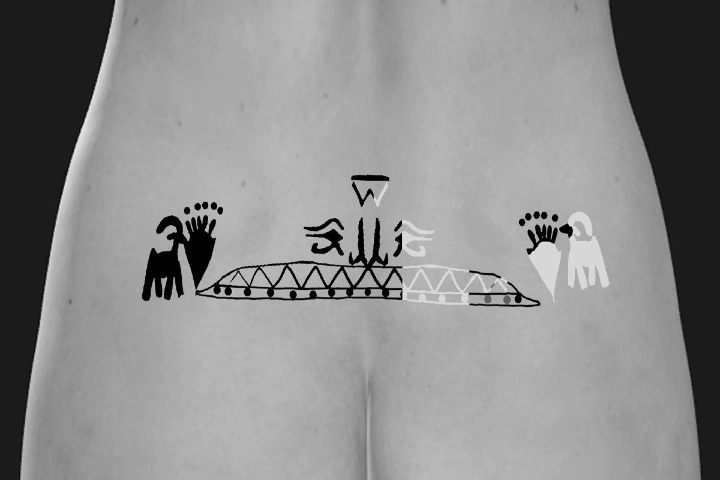

A reconstruction of a tattoo on the lower torso and legs of one of the mummified Egyptian women (Pic. Courtesy livescience.com)
If one thinks tattooing the lower back of the body is trendy and a fashion statement among celebrities and glitterati, think again! Three millennia ago, it was prevalent in ancient Egypt as shown in new archaeological evidence from mummies as per a report in livescience.com.
Tattoos were found by researchers Anne Austin and Marie-Lys Arnette on mummies and tattooed figures from the New Kingdom site of Deir el-Medina – a township that existed from 1550 B.C. to 1070 B.C.
The details of this finding have been published in the Journal of Egyptian Archaeology and it connects these tattoos to the ancient Egyptian god Bes – protector of women and children, particularly during childbirth.
Located on the Nile’s western bank Deir el-Medina was excavated in 1922 by a team of French researchers. In the period of the New Kingdom it was known as Set-Ma’at or the “Place of Truth”. This planned town was home to workers connected with the building of tombs of Egyptian rulers.
While a lot of evidence has been found about the life of common people in this town there was no mention of tattooing. Thus, it was shocking to uncover at least six tattooed women at Deir el-Medina. Commenting on this, Austin, the study’s lead author and bioarchaeologist at University of Missouri-St. Louis, said: “It can be rare and difficult to find evidence for tattoos because you need to find preserved and exposed skin. Since we would never unwrap mummified people, our only chances of finding tattoos are when looters have left skin exposed and it is still present for us to see millennia after a person died.”
Austin came across the two tombs in 2019. One included a middle-aged woman’s left hip bone, whose skin retained patterns of dark black that ran along her lower back. The horizontal lines of the tattoo on the left showed Bes and a bowl – an image connected with ritual purification weeks after childbirth.
The second tattoo again from a middle-aged woman which was brought to light through infrared photography as it was too faint to be seen by naked eye. Its reconstruction uncovered an Eye of Horus or wedjat and a possible picture of Bes adorned with a feathered crown. The two pictures point to well-being, protection and healing. As per Austin the zigzag line pattern stands for a Nile marsh which is connected with cooling waters that provided relief from pain suffered during childbirth and menstruation.
Arnette, the study’s co-author and an Egyptologist from Baltimore’s Johns Hopkins University in addition studied three clay figurines found several years ago at Deir el-Medina that represented women’s bodies. They too showed tattoos on the lower back and upper thighs and included a portrayal of Bes.
In their paper, the researchers concluded that “these tattoos and representations of tattoos would have visually connected with imagery referencing women as sexual partners, pregnant, midwives, and mothers participating in the post-partum rituals used for protection of the mother and child.”
Sonia Zakrzewski from United Kingdom’s University of Southampton who was not part of the study in an email to Live Science suggested that “these tattoos are imprinting protective representations — including of gods — on their body, almost like the person has their own portable magical amulet with them.”
Also read: Discovery of Khuwy’s body reveals that ancient Egyptians had mastered mummification 4,000 years ago
The sixteenth meeting of the India-Nepal Bilateral Consultative Group on Security Issues (INBCGSI) was held…
Finance Minister Nirmala Sitharaman on Monday lauded the resilience of Indian exporters, highlighting that the…
Israel Defence Minister Israel Katz has accused Iran of violating the ceasefire and said that…
External Affairs Minister S Jaishankar held a meeting with South Australia's Governor Frances Adamson in…
Union Minister for Communications and Development of the Northeastern Region Jyotiraditya Scindia on Tuesday highlighted…
India handed over 1000 metric tonnes of rice and essential medicines to Cameroon. Cameroon's Minister…